Discover the enigmatic world of knops in the Bible, where ancient symbolism and craftsmanship converge in sacred spaces.
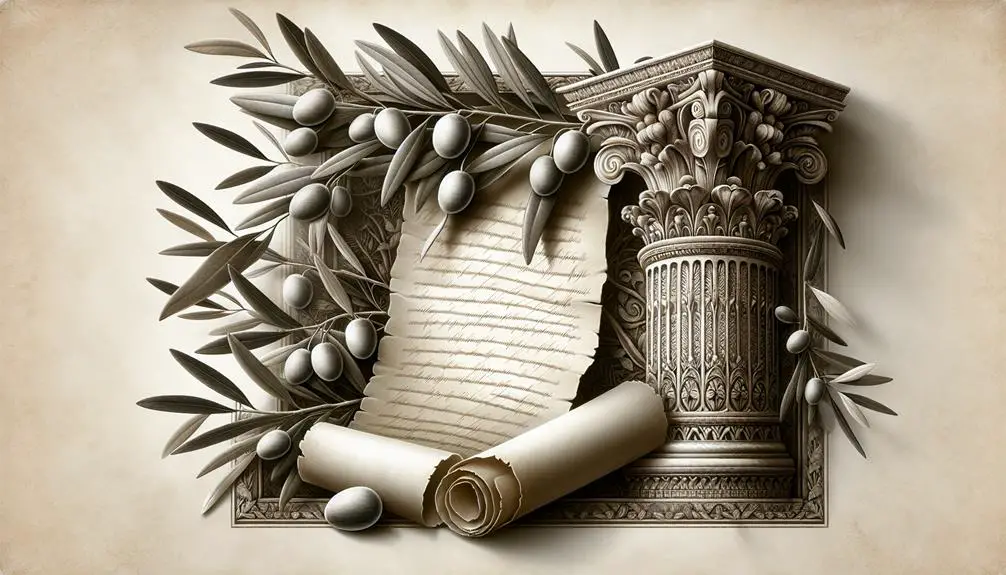
What Are Knops in the Bible
You've likely heard theories about knops in the Bible, but what's the real story behind these mysterious elements? These decorative features, mentioned in the context of Solomon's Temple and other significant religious artifacts, hold a fascinating blend of historical, cultural, and religious significance.
As you explore the intricate relationship between knops and their symbolic interpretations, you'll uncover insights into ancient craftsmanship, design principles, and perhaps even the mindset of the people who incorporated them into sacred spaces.
The journey through scripture to understand knops will surely reveal more than just their aesthetic value.
Key Takeaways
- Knops in the Bible symbolize life, fertility, and divine renewal.
- They represent the unity between spiritual and physical realms.
- Knops are integral to biblical temple decorations, enhancing their sacred atmosphere.
- Their use in biblical contexts reflects ancient spirituality and theological principles.
Defining Knops in Scripture
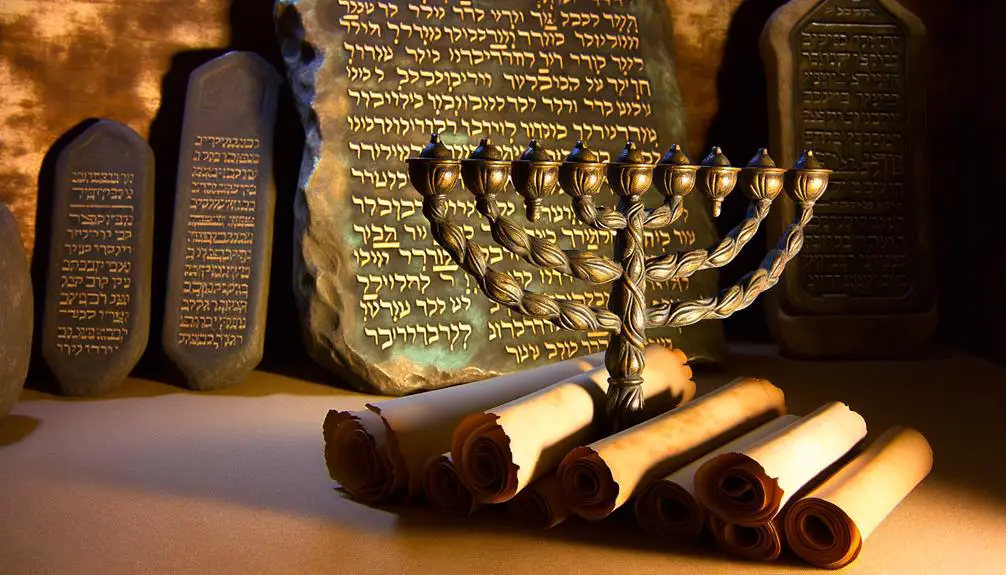
In biblical texts, 'knops' refer to decorative elements resembling small knobs or buds, often mentioned in the context of sacred furnishings and architecture. You'll find that the term originates from a period when symbolism played a pivotal role in religious expression, serving not only as ornamentation but also as a medium through which spiritual and theological concepts were communicated. The knop, in its essence, might've been inspired by natural forms, suggesting an attempt to encapsulate the divine creation in a tangible, visual form within sacred spaces.
Analyzing knop origins requires delving into ancient craftsmanship and the symbolic language of the time. These elements, though small in size, carried significant symbolic weight, potentially representing concepts like life, fertility, or divine presence. The precise interpretation of knops can be elusive, partly due to the sparse descriptions and the evolution of language and symbols over centuries.
Modern parallels to knops can be found in various forms of religious and secular architecture, where decorative knobs and buds serve both an aesthetic and symbolic purpose. In contemporary design, such elements mightn't carry the same sacred significance, but they do echo the human tendency to adorn and attribute meaning to our surroundings. This continuity of decorative motifs from ancient to modern times reflects a deep-rooted human inclination towards beautification and symbolism.
The exploration of knop origins and their modern parallels offers a fascinating glimpse into how symbols transcend time, adapting to new contexts while retaining echoes of their ancient roots. It underscores the enduring human desire to infuse our spaces with beauty and meaning, a principle as relevant today as it was in biblical times.
Historical Appearance of Knops
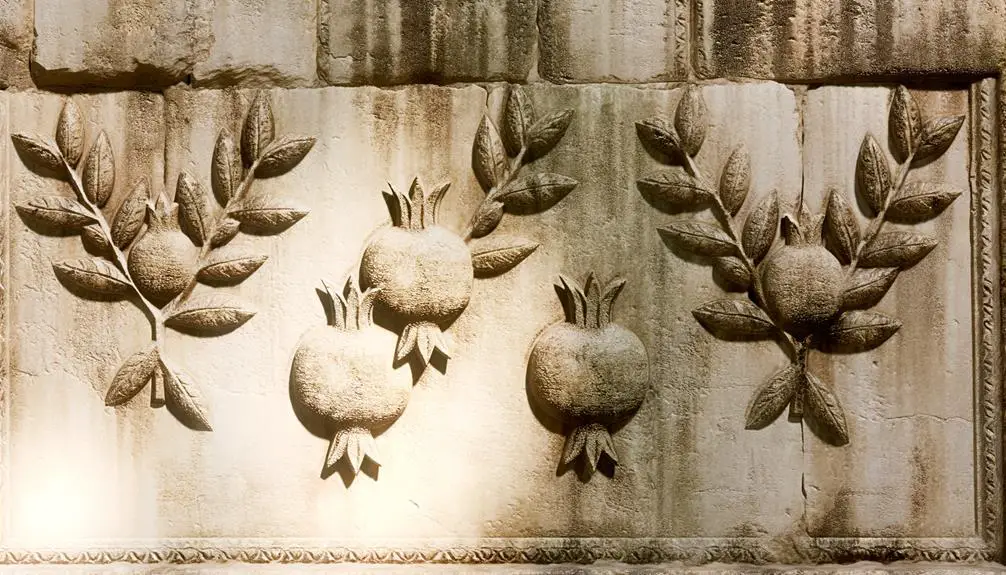
You'll find that knops, as mentioned in the Bible, bear a distinct appearance and role when explored through ancient texts and their symbolism. Their depiction not only sheds light on their aesthetic and functional purposes but also offers insights into the cultural and religious symbolism attributed to them in biblical times.
This analysis reveals the multifaceted significance of knops, extending beyond mere decorative elements to embody deeper spiritual meanings.
Knops in Ancient Texts
Throughout ancient texts, knops frequently appear, often symbolizing intricate artistic and religious significance. Their presence showcases a profound understanding of decorative techniques, highlighting the artisans' skills and the cultural value placed on these elements. The exploration of knops' origin reveals:
- Craftsmanship Evolution: Knops exemplify the advancement in decorative techniques over centuries, reflecting the artisans' ability to manipulate materials into complex shapes.
- Cultural Significance: They serve as a testament to the aesthetic and symbolic importance attributed by ancient societies.
- Material Diversity: Knops were made from a variety of materials, including metal, wood, and stone, demonstrating the wide range of resources utilized in their creation.
Analyzing these aspects sheds light on the multifaceted role of knops in historical contexts.
Symbolism of Biblical Knops
Delving into the realm of biblical knops, one discovers their rich symbolism and historical significance, which extends beyond mere decoration. These intricate elements, rooted in knop origins, serve as a testament to the meticulous craftsmanship and profound spiritual symbolism cherished by ancient civilizations.
The examination of knops in biblical contexts reveals a multifaceted interpretation, where they often symbolize life, fertility, and renewal. This symbolism isn't confined to the past; modern parallels can be drawn, illustrating the enduring nature of these motifs in contemporary religious and cultural expressions.
Understanding the historical appearance of knops, therefore, provides a unique lens through which to appreciate the continuity and evolution of symbolic language across ages, bridging ancient traditions with modern interpretations.
Symbolic Interpretations

In biblical texts, knops often carry rich symbolic meanings that scholars have interpreted in various ways. These interpretations provide insight into the deeper layers of biblical narratives and artifacts, bridging ancient traditions with contemporary understanding. When you delve into the symbolism of knops, you engage with a tradition that stretches back millennia, yet remains relevant to modern interpretations.
Regarding knops imagery, scholars have proposed several key interpretations:
- Representation of Life and Fertility: Knops, often resembling buds or bulbs, are thought to symbolize new life, growth, and fertility. This interpretation connects to the broader theme of renewal and divine creation found throughout the Bible.
- Symbolic of God's Presence: In some contexts, knops are seen as symbols of God's omnipresence and omnipotence. The intricate design and placement of knops in sacred objects or architecture are believed to reflect the divine order and the meticulous care with which God oversees the world.
- Unity and Connection: Knops can also represent the interconnectedness of the spiritual and physical realms. This interpretation highlights the seamless integration of material and spiritual elements in the divine scheme, emphasizing the holistic nature of biblical teachings.
These interpretations vary widely, but they all contribute to a richer understanding of biblical symbolism. By exploring the symbolic meanings behind knops imagery, you gain insights into the multifaceted ways in which ancient peoples expressed their spirituality and conceptualized their world. Whether you're a scholar, student, or simply someone interested in biblical history, the study of knops offers a unique lens through which to view the sacred texts.
Knops in Temple Design

Having explored the symbolic interpretations of knops, let's now examine their specific role and significance in temple design. In ancient times, knops were integral to the aesthetic and structural elements of temples, reflecting both beauty and sacredness. These ornamental features weren't merely decorative; they served to underscore the sanctity of the space, guiding worshippers into a deeper reverence for the divine.
Knop preservation techniques have been vital in maintaining the integrity of these ancient artifacts. Conservators employ meticulous methods to ensure that knops, despite their age, continue to convey their original splendor and significance. Techniques include controlled environments to prevent degradation, careful cleaning processes to avoid damage to the delicate surfaces, and sometimes, minimal restoration to preserve their historical authenticity.
In parallel, modern knop reproductions play a significant role in contemporary temple design. These reproductions, crafted with an eye towards historical accuracy, allow for the continuation of traditional aesthetics in modern constructions. They bridge the gap between ancient symbolism and contemporary worship practices, ensuring that the spiritual language of knops remains alive and relevant.
Materials and Craftsmanship
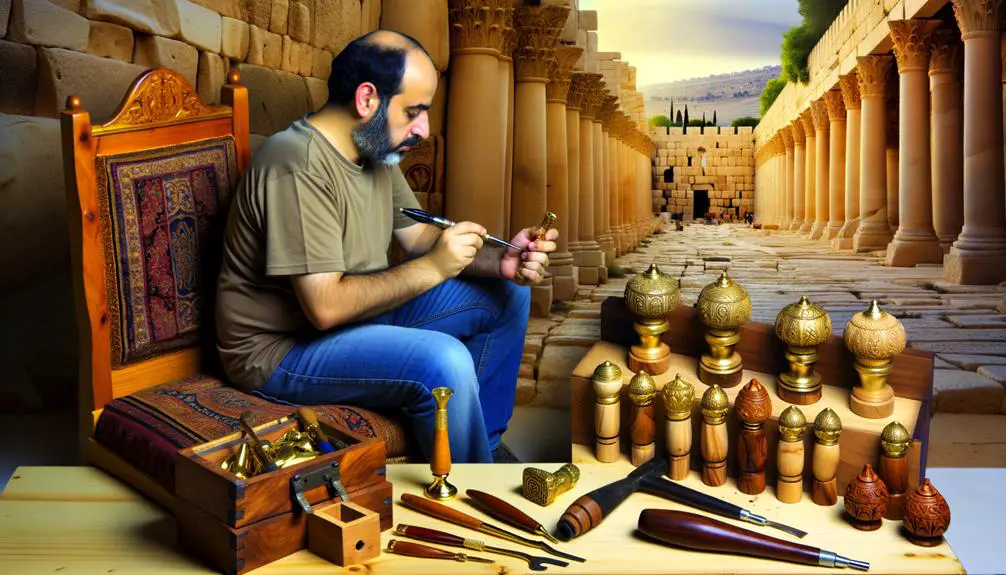
The choice of materials and precision in craftsmanship significantly influence the aesthetic and durability of knops in temple architecture.
You'll find that the artisans of ancient times meticulously selected materials that not only reflected the sanctity of the temple but also ensured that these decorative elements could withstand the passage of time.
This careful consideration extends to modern reproductions, where contemporary craftsmen endeavor to emulate the ancient techniques and materials to preserve the authenticity and historical accuracy of these artifacts.
When examining the materials and craftsmanship of knops, it's crucial to consider:
- The Variety of Materials Used: From gold and bronze to wood and stone, the materials chosen for knops varied significantly depending on their placement within the temple and the resources available. Each material required a specific set of skills and tools to be shaped into the desired form, reflecting the high level of craftsmanship of the artisans.
- Artistic Influences: The design and execution of knops weren't solely functional; they were also deeply influenced by the cultural and artistic norms of the period. This aspect is crucial in understanding the stylistic variations seen across different regions and epochs.
- Technological Advancements: Over the centuries, the introduction of new tools and techniques has allowed for more intricate designs and durable constructions. Modern reproductions of biblical knops benefit from these advancements, enabling craftsmen to achieve a level of detail and durability that closely mirrors that of their ancient counterparts.
Analyzing the materials and craftsmanship involved in the creation of knops reveals a deep respect for tradition, artistry, and technological progress, underscoring the sacred importance of these elements in temple architecture.
Knops in Ritual Context
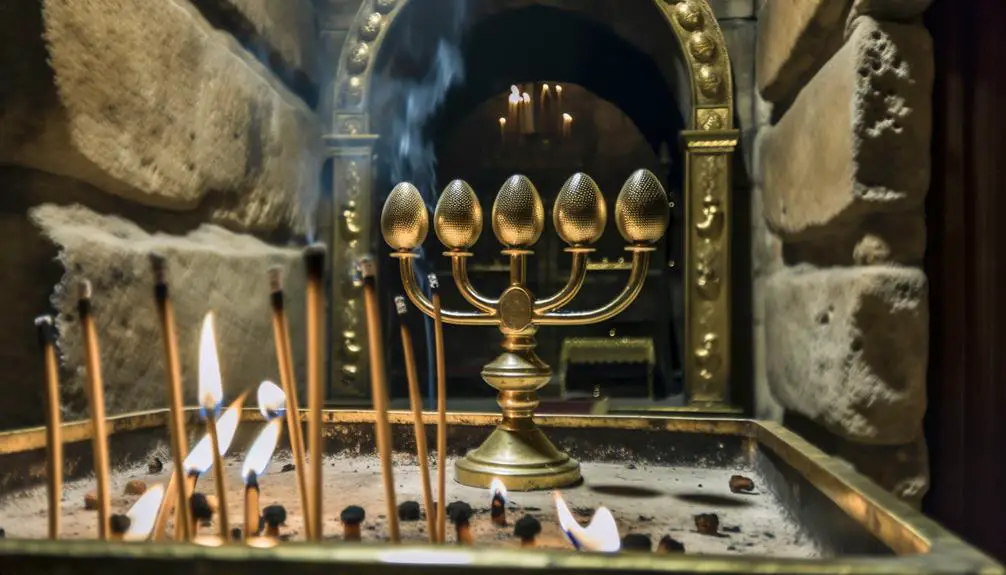
You must consider the symbolic meaning of knops within the context of ancient rituals to fully appreciate their significance in biblical texts. These ornamental features weren't merely decorative but held deeper spiritual implications, especially when integrated into temple decorations.
Their presence in sacred spaces underscores their role in enhancing the ritualistic atmosphere, inviting a closer examination of their symbolic and functional contributions to religious practices.
Symbolic Meaning
In biblical contexts, knops often symbolize continuity and connection within sacred rituals, reflecting a deeper spiritual significance. This symbolic meaning emerges from their design and placement, which can trace back to:
- Knop origins: Historically, knops have roots in ancient craftsmanship, often reflecting themes of life, fertility, and renewal. These elements underscore their role in ritualistic practices, emphasizing the cyclical nature of spiritual beliefs.
- Modern parallels: Contemporary religious artifacts sometimes mirror the symbolic use of knops, showcasing how ancient symbols can persist in modern faith expressions.
- Analytical interpretations: Scholars analyze knops to understand their function in religious ceremonies, suggesting they serve as tangible links between the divine and the earthly, facilitating a deeper spiritual engagement for participants.
This analysis reveals knops as more than decorative; they're integral to the fabric of biblical ritual, embodying complex theological concepts.
Temple Decorations
Knops, as integral elements of temple decorations, significantly contribute to the ritual context by embodying theological principles and facilitating a deeper connection between worshippers and the sacred. These ornamental features, often overlooked, hold profound symbolic meaning, deeply rooted in ancient traditions.
Their presence in temple architecture not only enhances the aesthetic appeal but also serves as a constant reminder of the spiritual realm that the physical structure seeks to represent. Modern adaptations of knops in religious architecture, while varying in design, continue to reflect their original purpose, illustrating the enduring influence of these ancient symbols.
The architectural influences seen in contemporary religious buildings underscore the timeless nature of knops, bridging the gap between past and present, and underscoring their role in enhancing the sacred atmosphere.
Cultural and Religious Significance

Understanding the cultural and religious significance of knops within biblical texts offers insights into the ancient world's symbolic language and ritual practices. These decorative elements, often found adorning sacred objects and spaces, serve as more than mere aesthetic enhancements. They embody a deeper symbolic resonance within the religious and societal frameworks of the times.
- Knops Origin: The origin of knops traces back to ancient craftsmanship, where they were meticulously integrated into religious artifacts and temple decorations. This practice highlights a profound reverence for beauty and detail in sacred contexts, suggesting that these adornments were imbued with symbolic meanings, possibly representing life, fertility, or divine protection. The precise interpretation of these symbols may vary, but their presence underscores a universal human inclination to seek connection with the divine through the material world.
- Modern Parallels: In contemporary times, one can observe parallels in the use of symbolic decorations within religious and cultural artifacts. Just as knops served to convey deeper meanings and connect believers with their faith, modern religious artifacts often incorporate symbols to express theological doctrines or spiritual concepts, bridging the gap between the tangible and the intangible.
- Analytical Insights: A scholarly examination of knops and their significance sheds light on how ancient societies expressed their spiritual beliefs and cultural values through art and architecture. This exploration reveals the enduring human desire to infuse the material world with spiritual meaning, a practice that transcends time and culture.
Frequently Asked Questions
How Have Modern Interpretations of Knops Evolved Compared to Ancient Understandings, and What Influences Have Shaped These Changes?
You've noticed that the interpretative evolution of knop symbolism has shifted dramatically from ancient to modern times. This change has been shaped by cultural, theological, and artistic influences that have redefined their meanings.
Initially, knops were likely understood in a more literal or direct religious context. Today, you're seeing a broader, more nuanced interpretation that incorporates historical, cultural, and even psychological dimensions, reflecting a more complex understanding of these ancient symbols.
Are There Any Contemporary Religious or Cultural Practices That Still Incorporate the Use of Knops, and How Are They Integrated?
You might find that contemporary religious or cultural practices incorporating knops often reflect a deep-seated symbolism, rooted in ancient traditions. These practices adapt knops with a keen awareness of their historical and spiritual significance, blending them seamlessly into modern rituals.
Cultural adaptations ensure knop symbolism remains relevant, bridging the gap between past and present. This integration demonstrates a thoughtful consideration of tradition, while embracing the evolution of cultural expression.
Can Parallels Be Drawn Between the Biblical Knops and Similar Artifacts or Symbols Found in Other Ancient Civilizations Outside of the Biblical Context?
Interestingly, you'll find that many ancient civilizations outside of the biblical context share striking similarities with biblical knops through cultural symbolism and artifact comparison.
These parallels aren't coincidental but reflect a broader human penchant for symbolizing concepts like life, fertility, or divinity.
How Have Knops Been Represented in Religious Art and Architecture Outside of the Direct Biblical Narrative, Especially in Periods Like the Renaissance or the Baroque?
You've noticed that in religious art and architecture, particularly during the Renaissance and Baroque periods, knops have been depicted with a rich blend of symbolism and aesthetics.
These periods emphasized Renaissance symbolism and Baroque aesthetics, integrating knops not just as decorative elements but as symbols with deep theological and philosophical meanings.
This representation underscores a broader cultural and religious significance, transcending their initial biblical context.
What Are the Most Common Misconceptions About Knops in the Bible, and How Do These Misconceptions Impact the Understanding of Biblical Texts and Artifacts Today?
You're often misled by modern misconceptions about knop symbolism in the Bible, thinking they're merely decorative. This misunderstanding skews your interpretation of biblical texts and artifacts, overlooking their deep symbolic meanings.
Historical contexts reveal knops symbolize life, connection, and divinity, enriching your comprehension of religious narratives. Unraveling these misconceptions is crucial for a nuanced understanding, ensuring you don't underestimate their significance in biblical stories and symbols today.
Conclusion
In conclusion, you've delved into the multifaceted role of knops within biblical text, uncovering their historical, symbolic, and material significance. These elements, from temple design to ritual context, underscore their profound cultural and religious importance.
Investigating the theory that knops symbolize unity and protection offers intriguing insights. This analytical journey reveals the depth of craftsmanship and symbolism in ancient religious artifacts, inviting further exploration into their enduring legacy.



Sign up